Xreal Beam Pro Review: 3D camera at a bargain price?
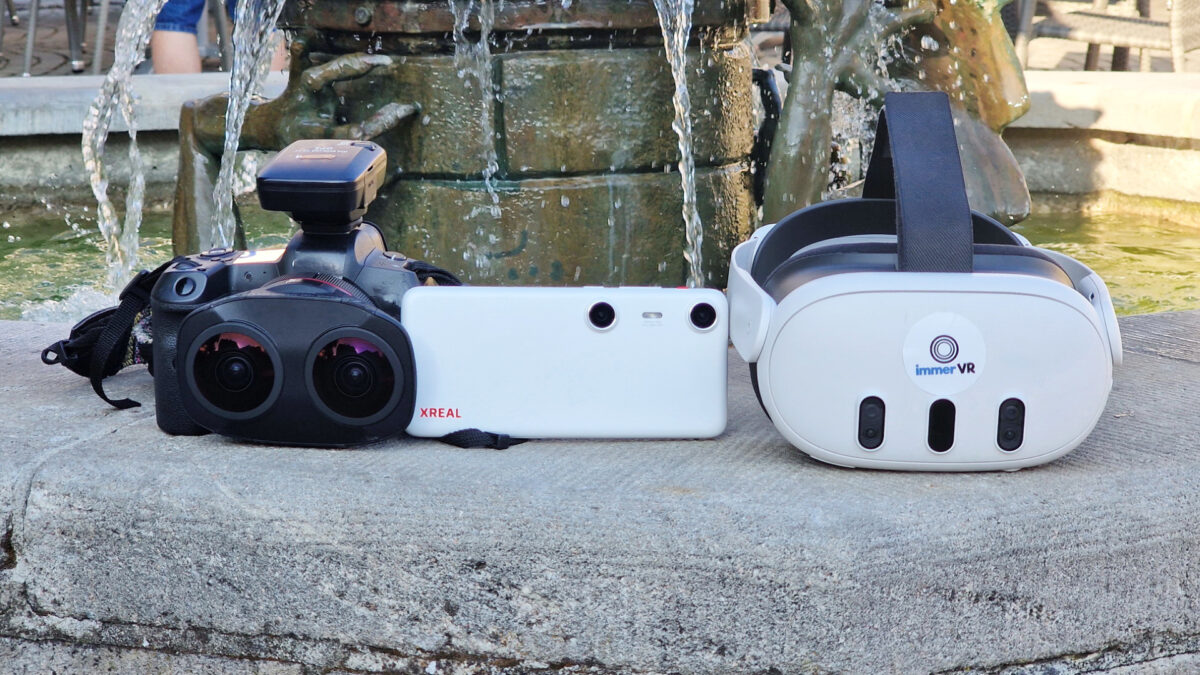
The Xreal Beam Pro is the most affordable entry into 3D media production. Read my review to find out if this compact camera is worth it for 3D short films.
An article by Daniel Pohl
There is a lot of movement in the 3D virtual reality market. While we recently reported on the VR180 3D camera from Calf Visinse for consumers, there is now a new, interesting camera for 3D short-angle shots: The Xreal Beam Pro.
It does not produce 180° x 180° immersive media, but content reminiscent of 3D cinema and 3D television. One of the advantages of short-angle 3D cameras is that there are more pixels available per viewing angle, resulting in a sharper image. How relevant this is and how it compares to other 3D cameras is shown in this review.
Content
Xreal Beam Pro: Review in a nutshell
With the competitive price of $199 for Beam Pro, you get a relatively high-quality 3D camera that easily surpasses the "Spatial Photos" of the iPhone 15 Pro (Max). The 3D photos have a resolution of 3840 × 2880 per eye. Videos are recorded in 1920 × 1080 per eye at 60 fps. The large screen of the Android device serves as a preview and displays a spirit level for correctly aligning the content, which is very important for creating good 3D media.
The Xreal Beam Pro is suitable for you if ...
- are looking for an inexpensive and very good device to get started with the short-angle 3D format
- you don't want to lug around large camera rigs
The Xreal Beam Pro is less suitable for you if ...
- you want to record (semi-) spherical media such as VR180 or 360° media
- you already own an iPhone 15 Pro (Max) or iPhone 16 and are satisfied with the quality of the "Spatial Photos" and "Spatial Videos"
Background to Xreal
Xreal was formerly known as Nreal, but had to change its company name for trademark reasons. The company mainly sells headsets with displays, such as the Xreal Air 2, which are powered by a puck that contains both the battery and the computing unit.
In this case, the puck is the Xreal Beam Pro with the 3D camera. I won't go into the Xreal glasses with display in this article, which have a field of view of about 50°, which is much less immersive than a Quest 3 with a horizontal field of view of 110°, and I've never had them on. For me, the more exciting component that can be purchased separately is the Xreal Beam Pro because of the integrated 3D camera.
This is Xreal Beam Pro
The device itself looks like a typical Android smartphone. However, it does not currently have the ability to make calls. According to rumors, a 5G version is in the works, but it might only be released for the Chinese market. From the outside, the first thing you notice are the two USB-C ports. One of them is for charging only, while the other can be used for both connecting the Xreal Glasses and for USB data transfer to the PC.
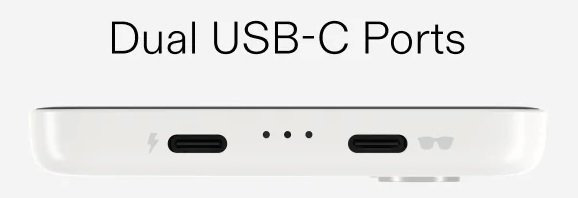
The two USB-C ports on the underside of the XREAL Beam Pro. One for charging, one for data exchange. | Image: XREAL
The next noticeable feature is that the two camera lenses are further apart. Xreal has taken the clever step of keeping the 50 mm distance between the lenses relatively close to the average human IPD of 63 mm.
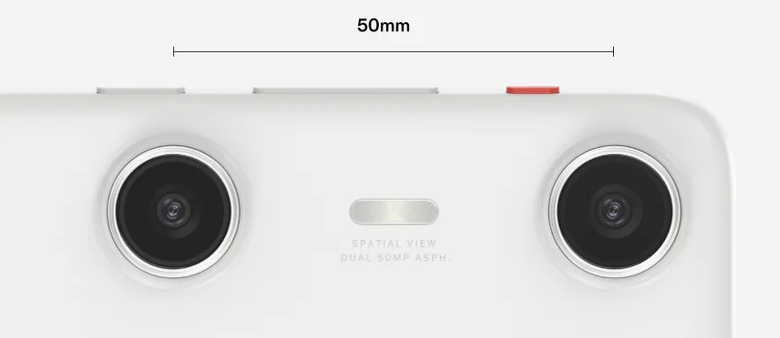
The two identical camera lenses of the Beam Pro are 50 mm apart. | Image: XREAL
On the iPhone 15 Pro, for example, the lenses for "Spatial Video" are about 19.5 mm apart and therefore have less parallax. Xreal takes the opportunity to attack Apple's design. In a picture on their website, they show the difference between an unspecified setup with only 19 mm lens distance (= iPhone) and their own design, in which the left and right images capture significantly more differences.
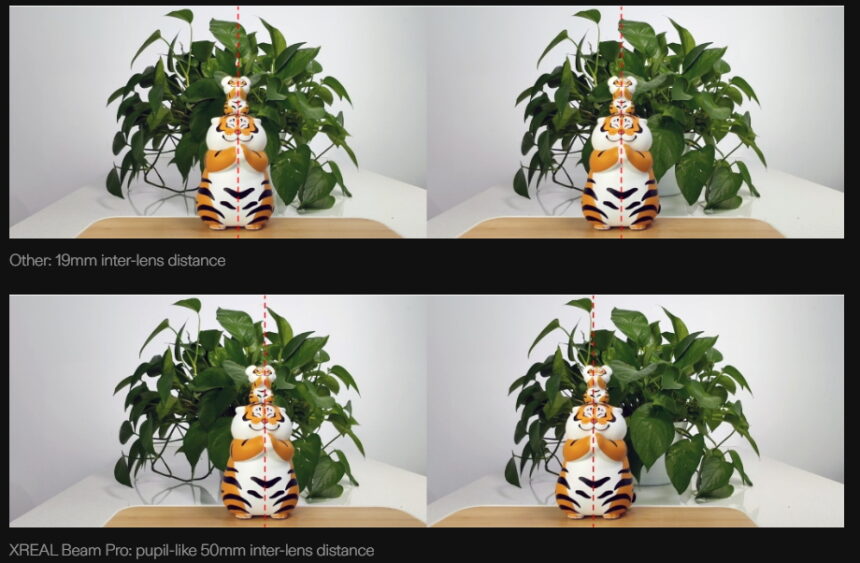
Xreal visualizes the difference in parallax in a setup analogous to iPhone 15 Pro (Max) and their own setup with 50 mm lens distance. | Image: Xreal
The home screen greets us with a typical Android look. The "pig's nose" icon is a little unusual at first, as you might not intuitively associate it with the camera app.
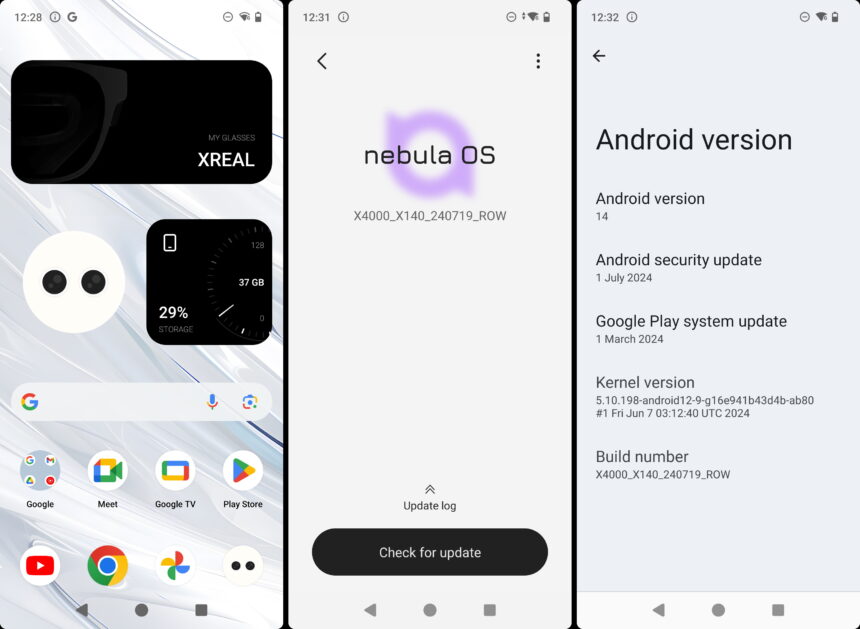
The device has a typical Android design. XREAL's nebula OS is based on Android 14 | Image: Daniel Pohl
The operating system pretends to be Nebula OS. However, a look at the device's settings shows that it is an operating system based on Android 14. In the image above, we can also see the remaining memory of the device in the configuration with 128 GB of internal memory on the left.
Despite the fact that hardly any applications have been added, there are only 37 GB left after the OS update. Anyone who regularly transfers media to their computer should be able to cope with this. One minute of 3D video (50 Mbps) is about 400 megabytes per minute. For 3D images in .jpg format, you can expect about 8 megabytes per image. Memory can be expanded to up to 1 TB using a microSD card.
The current 3D camera application on the Beam Pro is relatively limited. The 3D mode uses a fixed focus point. You can change the brightness by tapping an area of the touchscreen and then moving the +/- slider. Manual settings for exposure time, ISO or other details that some camera professionals expect are currently not possible. In most cases, however, the automatic settings work very well.
3D cameras in comparison: Canon EOS R5 (5.2mm) vs. Xreal Beam Pro vs. Meta Quest 3
I make the unusual comparison between Canon's professional solution with the EOS R5 and the 5.2 mm dual fisheye lens (VR180), the Xreal Beam Pro and the built-in 3D camera in Meta Quest 3, which is immerGallery in the app without Guardian restrictions.
It is clear that the VR180 vs. regular 3D formats alone and the cost of $6,000 for the Canon setup vs. almost free for Quest 3 owners means that the cameras appeal to different target groups.
However, it will be interesting to see to what extent the shorter-angle cameras can exploit their resolution at lower viewing angles and whether the 3D camera solution for Quest 3 is at all suitable for beginners.
The data of the three cameras at a glance:
| EOS R5 + 5.2mm | XREAL Beam Pro | Quest 3 | |
| Format | VR180 | Regular 3D | Regular 3D |
| Field of view | approx. 173° without lenses | 86° | 80° (?) |
| Sensors | CMOS (36 x 24 mm) | Samsung S5KJN1 (1/2.76") | ? |
| Aspect Ratio | 1:1 | 4:3 | 1:1 |
| Photo resolution (per eye) | 3840x3840 | 3840x2880 | 1920x1920 |
| Video resolution (per eye) | 3840x3840 @ 30 fps (EOS R5 C: 60 fps) | 1920x1080 @ 60 fps | 1920x1920 @ 60 fps |
| Lens distance | 60 mm | 50 mm | 65 mm |
| price | $6.000 | $199 | For Quest 3 owners: $25 for camera app Quest 3 new price: $500 |
To test the sharpness of the cameras in practice, I photograph a scene in Herzogenaurach, Germany, where I have attached a round camera test pattern to a fountain.
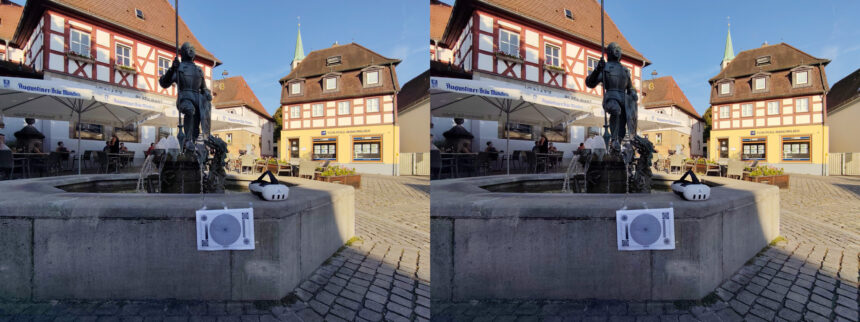
Test photo with the XREAL Beam Pro and a camera test pattern. | Picture: Daniel Pohl
The images from the different 3D cameras are shown here accordingly. The EOS R5 image appears slightly distorted due to the spherical, equirectangular image format. When viewed in VR, however, it is displayed correctly again.

Crops of the test sample of the EOS R5 (5.2mm), XREAL Beam Pro and the 3D camera of the Quest 3 | Image: Daniel Pohl
The evaluation of the test sample shows that the Beam Pro achieves the best sharpness with its 3D short-angle images, even clearly outperforming the $6,000 Canon setup for VR180 in this respect. Nevertheless, the immersion of the Canon image in VR is higher, as the entire field of view is well covered, including small head movements, and therefore a greater presence is perceived.
The Beam Pro's image is also sharper in VR, but you don't get lost in it as much as with spherical media because it's displayed on a 3D cinema screen. As expected, the Quest 3's 3D camera, a virtually free experimental tool for headset owners, comes off worst in terms of sharpness due to its lower resolution.
Nevertheless, these photos show a good 3D effect in VR and are definitely worthwhile for beginners. Hopefully, future headsets will be equipped with two better color cameras and headset manufacturers will release the camera APIs for developers to create easy-to-use camera apps.
Comparison with iPhone “Spatial Photos”
With the iPhone 15 Pro (Max), it was previously only possible to record "Spatial Videos" in 1920 × 1080 per eye. However, higher-resolution 3D photos and videos were also possible with the Spatialify app. Apple's configuration for 3D in the new iPhone 16 series is still to generate the adjacent image for the other eye from a section of a different lens.
In the iPhone 15 Pro's spatial videos, which have been officially available so far, you can hardly see any difference due to the resolution. The situation is completely different with the higher resolution 3D photos via Spatialify with 4036 × 3024 pixels per eye. In the beautiful Spatial Photo collection of Tomislav from Croatia, you can see the technical limits of the different lenses in some of the pictures.
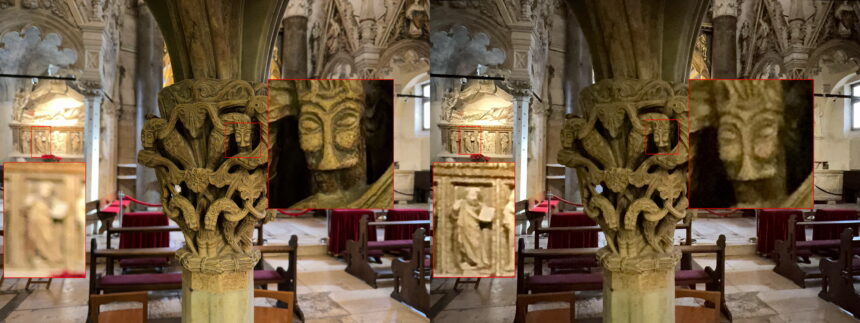
Highlighted differences of a Spatial Photo created with the Spatialify app on the iPhone 15 Pro. | Image: Tomislav Bezmalinović. Markings: Daniel Pohl
As you can clearly see in the picture, the sharpness, details, contrasts, and colors are different between the left and right eyes. In human perception, this can make you realize that something is wrong. The body reacts as if it has been poisoned in the Stone Age and produces nausea — known as motion sickness in VR. There is also eye strain when you try to focus with both eyes at the same time, but one of the images is blurry.
As nice as it is that a major smartphone manufacturer making a 3D camera standard will put this feature into hundreds of millions of hands, it can also quickly turn users off to the technology if the 3D is poor. "3D makes me sick" is something I'm sure some of you or your friends have said after watching a 3D movie.
If you are not sitting in the middle of the screen, the 3D experience is significantly worse. Ghosting of about 10% (the left eye sees the content intended for the right eye with about 10% brightness) can also cause discomfort.
Fortunately, in VR, the screen areas for the eyes are completely separate, so at least ghosting is not a problem with VR headsets. Since the iPhone 16 series now supports Spatial Photos as well, I am curious about the possible resolutions and if the difference between the left and right image can be minimized.
For Samsung, who wants to release a new VR/MR headset with Google, this would be the perfect chance to trump with a better 3D camera setup in the new Samsung Galaxy smartphone series: two identical lenses and a larger distance between the lenses. Unfortunately, if the rumors and leaked renders of the upcoming Galaxy S25 are to be believed, this will not be the case with the next generation in spring 2025.
Instead, as with the iPhone 16, the resolution of the ultra-wide-angle camera seems to have been increased, which should at least allow for a better crop, if Samsung addresses 3D media at all. But maybe we will be surprised with "one more thing...". Xreal is definitely on the right track with the Beam Pro and shows how to properly integrate a 3D camera into a smartphone form factor.
Xreal Beam Pro practical tips
Here are some practical tips after weeks of using the device and browsing the discussions on the Photo-3D group:
- Updating to the latest operating system is recommended
- Sometimes the quick launch of the camera app via the power button does not work. To do this, activate the toggle for "Use device controls: Without unlocking your device" in the settings under Lock Screen
- If you mainly use the device as a camera, it may be worth deactivating the Wi-Fi and/or making modifications to "App battery usage" in the app settings. Almost all apps can be set to "restrictive", which blocks unnecessary processing in the background and extends the battery life.
- Logically, a 3D camera records different areas for left and right. This means, for example, that there is data on the left-hand side of the left-hand image that is not on the left-hand side of the right-hand image. This can lead to an unsightly conflict when viewing (see above, motion sickness, eye strain). It is recommended to optimize all images in a batch process using the free Windows tool Stereo Photo Maker Pro. In the English version: File - Multi Job, Multi Conversion - Select all jpg on the PC. Activate "Adjust Auto Alignment" and "Auto Crop after adjustment". Select Output Folder. Start with "Convert Selected Files".
Example photos Xreal Beam Pro
To get a better impression of the 3D photos, I have put together a gallery with almost 40 pictures of cities, gardens, and cosplay and a video. You can either download the 300 MB .zip archive with the media for Beam Pro manually or get it directly in the immersive media viewer immerGallery with just a few clicks.
To do this, go to immerGallery, click on Download, Custom URL, change the dropdown to immervr:// and type xreal into the address field. Then "Go!".

Simply download the XREAL Beam Pro sample files in immerGallery under Download, Custom URL. | Image: Daniel Pohl
My verdict on Xreal Beam Pro
Xreal Beam Pro does a lot of things right at a very reasonable price of just $199 for the smallest memory version. This makes it the cheapest entry into 3D media production, has a compact form factor, and produces relatively high-quality images and videos. Due to the very good price-performance ratio, the 3D camera gets my full recommendation.
Only the announced Acer SpatialLabs Eyes 3D camera for about $500 could be better suited for short-angle 3D, but for about 2.5 times the price. It produces even wider images with a larger aspect ratio. This allows the field of view in VR to be completely filled horizontally, which increases immersion.
If, on the other hand, you want the semi-spherical VR180 3D format with the highest immersion, you should take a look at the Calf Visinse, which will be available at a reduced price of around $600.
The author Daniel Pohl is CEO and founder of immerVR GmbH. There, Daniel deals daily with innovations in the field of immersive media, mostly in the area of VR180 stereo photos and stereo videos. With his app immerGallery (Meta Horizon Store, Steam Store), you can experience highly immersive photo galleries with voice-overs and background music in various VR formats on Meta Quest devices. The app also supports video playback for normal 2D / 3D, 180° and 360°.
Note: Links to online stores in articles can be so-called affiliate links. If you buy through this link, MIXED receives a commission from the provider. For you the price does not change.